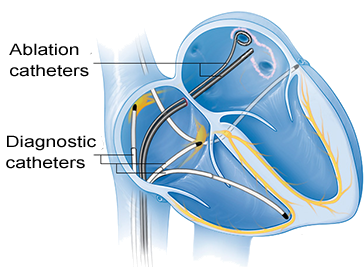Catheter Ablation
- Is a therapeutic procedure during an electrophysiological study
- Involves irreversible damage (destruction) of the anatomical area
- Which is responsible for the development of arrhythmia
- The most commonly used technique is radiofrequency ablation (RFA)
- RFA involves burning tissue with high-frequency current
- Less commonly, cryoablation (freezing tissue) is used
- RFA is used in the treatment of:

AVRT in WPW syndrome
Sources
- ECG from Basics to Essentials Step by Step
- litfl.com
- ecgwaves.com
- metealpaslan.com
- medmastery.com
- uptodate.com
- ecgpedia.org
- wikipedia.org
- Strong Medicine
- Understanding Pacemakers

Home /
Electrophysiology Study
Electrophysiology study (EPS)
Electrophysiological Catheters
- During an electrophysiological study, catheters are introduced into the heart chambers
- under X-ray control
- Most commonly through the femoral vein or subclavian vein
- Catheters are classified as
- Electrophysiological study using catheters
- maps, induces, or removes the substrate of arrhythmia
|

|
Electrophysiological Study
- Diagnostic catheters are typically placed in:
- Each intracardiac catheter records impulses directly from the endocardium
- Catheters can generate impulses and artificially induce arrhythmias
- This is used for arrhythmia diagnosis

Normal Impulse Conduction and Electrophysiological Study
- ECG is the ECG trace from a 12-lead ECG, recorded simultaneously with the electrophysiological study
- HRA (High Right Atrium)
- Records impulses in the upper part of the right atrium
- HBE (His Bundle Electrogram)
- Displays impulse conduction through the His bundle
- Impulse in the lower part of the atrium (1st deflection)
- Impulse in the His bundle (2nd deflection)
- Impulse in the ventricular septum (3rd deflection)
- RVA (Right Ventricular Apex)
- Records impulses at the apex of the right ventricle
Catheter Ablation
- Is a therapeutic procedure during an electrophysiological study
- Involves irreversible damage (destruction) of the anatomical area
- Which is responsible for the development of arrhythmia
- The most commonly used technique is radiofrequency ablation (RFA)
- RFA involves burning tissue with high-frequency current
- Less commonly, cryoablation (freezing tissue) is used
- RFA is used in the treatment of:
|

AVRT in WPW syndrome
|
Sources
- ECG from Basics to Essentials Step by Step
- litfl.com
- ecgwaves.com
- metealpaslan.com
- medmastery.com
- uptodate.com
- ecgpedia.org
- wikipedia.org
- Strong Medicine
- Understanding Pacemakers
| 






